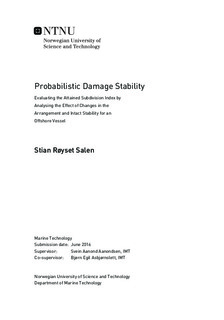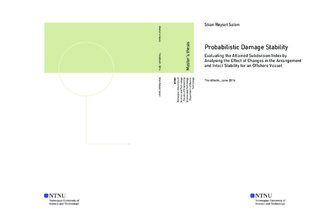| dc.description.abstract | The motivational basis and underlying goal of this master s thesis is to provide more knowledge to the experience data bank for ship designers with respect to probabilistic damage stability (PDS). More precisely, the thesis aims to give more insight to how certain changes in the arrangement and intact stability affect the PDS or A-index for a specific offshore vessel.
The author has co-operated with Salt Ship Design in order to achieve the abovementioned goal; a NAPA-license and GA drawings to a wind farm service vessel (WFSV) were provided. In agreement with Salt Ship Design, the following two objectives have been investigated:
1. What is the effect on the A-index of changing the size of the wing ballast tanks located above the void U-tanks at the mid-section of the WFSV, by changing the height of the horizontal surface ( U-deck ) separating these two tanks?
2. What is the effect on the A-index of changing the intact stability of the ship, i.e. the ship s initial GM values for the three subdivision draughts dS, dP and dL?
The background for the abovementioned goal and research questions, is the introduction of the PDS regulations by IMO in 2009. Ship designers were then forced to use the probabilistic approach instead of the deterministic approach (DDS), for certain vessel types when calculating damage stability. PDS offers more freedom than DDS in the design of the ship s internal watertight arrangement. However, since PDS calculations usually are conducted at late design stages due to the widely used top-down design approach, it may be challenging to utilise this flexibility due to time pressure. Thus, ship designers often rely on experience, since there is little time for research and optimisation. The author would therefore like to contribute with more knowledge to the ship designers experience data bank .
It can be concluded that the A-index in objective 1 generally decreases when U-deck is lowered beneath the maximum value on the curve, which corresponds to 5.6 m. From the analysis and discussion conducted in this study, it can furthermore be concluded that the factors contributing to the change are si and vi. The pi-factor does not contribute, since there are no changes in the arrangement in longitudinal or transverse direction. Both the si- and vi-factor generally decreases when the U-deck height is decreased below 5.6 m. For the si-factor, this is most likely due to increasing heeling moments, in case of damage, for larger sized wing ballast tanks; the si-factor is reduced due to larger heel angles. In addition, larger wing ballast tanks leads to smaller U-tanks, thus the stabilising effect of the U-tanks is reduced as well.
The results for objective 2 show that the A-index is generally better for larger initial GM values. The analysis and discussion related to objective 2, additionally conclude that the A-index is mainly dependent on the heeling moment in case of damage. The heeling moment will give the ship a new floating position, i.e. the ship obtains an equilibrium heel angle larger than zero degrees. This heel angle reduces the si-factor, which in turn reduces the A-index. The pi- and vi-factor will not contribute to the changes in A-index for objective 2, because there are no changes in the arrangement.
The abovementioned results and conclusions are the key findings in this thesis. Whether the results are generic or not, is questionable; for offshore vessels with approximately the same arrangement as the WFSV, the results from this thesis could be useful. | |

